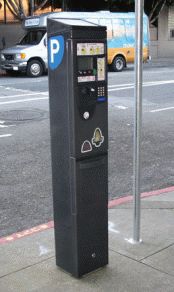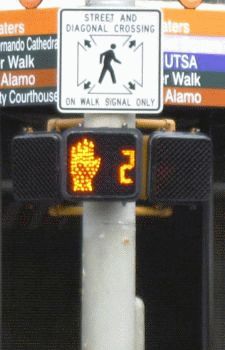Schematics are back!
A few years ago, I had schematics for most of the area’s freeways on my website. They were rather crude, so a couple of years ago, I embarked on a project to upgrade them. I got just one done (I-10 West) when I realized that the process of creating and maintaining them– especially given all the changes brought about by the massive amount of construction the past few years– just made them unwieldy and there was no way I would ever be able to get them all done. So when I updated my site earlier this year, I dropped that lone schematic while I investigated a different method of doing them. Finally, I think I have settled on a design that is substantially easier for me to put together and should be even easier to keep up-to-date, and one that is, frankly, easier to decipher and more informative than the old ones were. Yesterday, I posted the first one, which also happens to be I-10 West. Take a gander and let me know what you think.
New traffic sign needed: “Take turns”
Someone sent me this and I thought it was interesting enough to post here. It’s about four and a half minutes long and worth a look.
Fifty percent of traffic accidents happen at intersections. Gary Lauder, who is the managing partner of Lauder Partners, a venture capital firm, and the co-creator of the Socrates Society at the Aspen Institute, shares a brilliant and cheap idea for helping drivers move along smoothly: a new traffic sign that combines the properties of “Stop” and “Yield” — and asks drivers to be polite.
Pay-and-display could be coming downtown

Pay-and-display station in San Francisco
The San Antonio City Council this Thursday will consider whether to approve a plan to replace most downtown parking meters with so-called “pay-and-display” systems. (UPDATE: Council approved the plan during its 3/4/10 meeting.) These systems, which originated in Europe and have become popular in US cities over the past decade, consist of a payment machine (“pay station”) located on each block, such as the one pictured to the right. After parking your vehicle, you locate the nearest pay station, pay for the time you want to park, get a receipt from the machine, then return to your vehicle and place the receipt on your dashboard. The drawback to this system, of course, is that you have to walk to the machine (which typically is located mid-block), pay, then return to your vehicle to put the receipt on the dashboard. The benefits, however, are that the machines accept credit/debit cards and dollar bills, so no more having to scrounge for loose change. Also, motorists can move their vehicle if desired without having to “feed” another meter. The City is the biggest benefactor in the form of reduced maintenance costs and collection overhead for thousands of parking meters; remote maintenance of the machines via wireless connections; and enhanced revenue, likely the result of more people opting to pay since they can use credit cards and bills. Also, unlike with parking meters where any remaining time is inherently donated to the next person who parks in the space, leftover time under pay-and-display systems is essentially forfeited to the City. Studies generally show that parking violations are reduced under pay-and-display systems, so the City would lose some revenue from parking tickets, but can, as a result, reallocate those enforcement resources to other areas.
Gas taxes Toll roads: election Governor
by Brian
Comments Off on Governors’ transpo planks
Governors’ transpo planks
Well over a month ago now, I critiqued Kay Bailey Hutchison’s transportation policy plank of her gubernatorial platform. I had intended to review the other candidate’s proposals soon thereafter, but alas, got sidetracked. With the primary elections tomorrow, I thought it might be time to finally get to it. 🙂
The candidates’ (major candidates only) policy statements are evaluated in order of their current polling numbers, Republicans first.
Uncategorized: website
by Brian
Comments Off on Video added to TexasHighwayMan.com
Video added to TexasHighwayMan.com
 A couple of days ago, I mentioned an “exciting” new addition that I was working on for my website. Well, “exciting” might have been a bit of an overstatement, but it’s an addition I’ve wanted to make for a while now. That addition is videos of all the area freeways. I recently purchased a suction-cup camera mount for the windshield and, after some test runs, completed the first two videos (I-10 West inbound and outbound) earlier this week. Within the next couple of months, I hope to have all the city’s freeways filmed and posted. These will replace the so-called “driver’s view” pics that I had started to do. Shooting, editing, and posting the videos is a lot easier than a plethora of photos, so hopefully it will be easier for me to get the initial batch completed and also to keep them updated than it was going the photo route.
A couple of days ago, I mentioned an “exciting” new addition that I was working on for my website. Well, “exciting” might have been a bit of an overstatement, but it’s an addition I’ve wanted to make for a while now. That addition is videos of all the area freeways. I recently purchased a suction-cup camera mount for the windshield and, after some test runs, completed the first two videos (I-10 West inbound and outbound) earlier this week. Within the next couple of months, I hope to have all the city’s freeways filmed and posted. These will replace the so-called “driver’s view” pics that I had started to do. Shooting, editing, and posting the videos is a lot easier than a plethora of photos, so hopefully it will be easier for me to get the initial batch completed and also to keep them updated than it was going the photo route.
In addition, I’m going to use the videos to update my exit lists (much easier to do from a video than trying to write them down at 65 mph <g>) and also to build the new lane schematics (see the previous parenthetical note). I hope to get those done in conjunction with each video, although I haven’t done I-10’s yet.
To keep the clips within the YouTube guidelines (and to make them a little more interesting), the playback will be at double-speed (or even 4x for the longest ones.) I opted not to put a soundtrack over them; everyone has their idea of perfect “driving music”, so crank-up whatever you like to listen to when viewing them!
Roads Safety: pedestrian crossing traffic signals
by Brian
Comments Off on Pedestrian scramble update
Pedestrian scramble update
If you read my previous post about pedestrian scrambles, you know that it’s not the newest dance craze sweeping the nation, but rather an experiment by the City of San Antonio at improving vehicular and pedestrian traffic downtown by installing “exclusive pedestrian phases” at more than a dozen intersections. I was back downtown again today for a meeting with some colleagues and discovered two more intersections with the new setup that I missed last time: Navarro at Crocket and Navarro at College. Also, all of the locations along Commerce, Market, and Dolorosa that had not been activated last time were now online. Alas, though, still none at Convention Plaza.
While walking to lunch with my colleagues, we stopped for a “don’t walk” signal at one of the scramble intersections. One of them noticed that the signal for vehiclular traffic headed our direction was green but that we had a “don’t walk” signal and instinctively realized that something was amiss. Ah, she must not have read my blog! (Doesn’t everybody?) After I explained what was afoot (pun completely intended), she commented that she was really happy with the new configuration and couldn’t wait to cross diagonally– it was like being able to finally do something that had long been verboten.
While out and about, I noticed many other people taking advantage of the diagonal crossing ability. I did see a couple of instances, though, where people were crossing against the light and obstructing turning vehicles, thus thwarting the intent of the project. Over time, I’m sure people will understand and adjust to the changes.
Commuting Passenger rail: commuter rail light-rail
by Brian
Comments Off on The difference between commuter rail and light-rail
The difference between commuter rail and light-rail
Are you ready to do the pedestrian scramble?
 If you’ve been downtown lately, you might have noticed several intersections where pedestrians can cross in all directions (including diagonally) at once, a la the famous Shibuya crossing in Tokyo. The City of San Antonio is installing these crossings, known colloquially as “pedestrian scrambles” or “Barnes Dances” (or more boringly by their technical name of “exclusive pedestrian phasing”), as an experiment to see if they improve both pedestrian and vehicular traffic downtown. During a recent jaunt downtown, I counted 14 intersections outfitted with the equipment for pedestrian scrambles (that being a third pedestrian crossing signal on each corner oriented diagonally across the intersection), with half of them actually in service.
If you’ve been downtown lately, you might have noticed several intersections where pedestrians can cross in all directions (including diagonally) at once, a la the famous Shibuya crossing in Tokyo. The City of San Antonio is installing these crossings, known colloquially as “pedestrian scrambles” or “Barnes Dances” (or more boringly by their technical name of “exclusive pedestrian phasing”), as an experiment to see if they improve both pedestrian and vehicular traffic downtown. During a recent jaunt downtown, I counted 14 intersections outfitted with the equipment for pedestrian scrambles (that being a third pedestrian crossing signal on each corner oriented diagonally across the intersection), with half of them actually in service.


